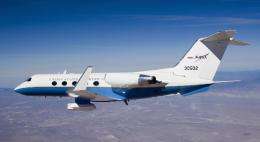NASA Radar Studies Continue in Central America, Hispaniola

(PhysOrg.com) -- NASA radar imaging flights over Central America, Haiti and the Dominican Republic are in the second week of a three-week campaign.
The JPL-developed Uninhabited Aerial Vehicle Synthetic Aperture Radar (UAVSAR) is currently in the second week of a three-week campaign in Central America, Haiti and the Dominican Republic. Flying beneath the belly of a modified Gulfstream III aircraft from NASA’s Dryden Flight Research Center, the sophisticated radar can spot minute changes in Earth's surface by flying precise repeat passes over targeted areas.
The Central American survey flights are focusing on measuring biomass in Central American rain forests, imaging volcanoes from Guatemala to Costa Rica, and imaging Mayan ruins. The flights over Haiti and the Dominican Republic are targeting earthquake faults on the island of Hispaniola.
Scientists collected data over Central American nations again on Feb. 2, and then flew a second set of data tracks over Haiti on Feb. 3 before returning to Costa Rica on Feb. 4.
More information: For more information on UAVSAR, see: uavsar.jpl.nasa.gov .
Provided by JPL/NASA

















